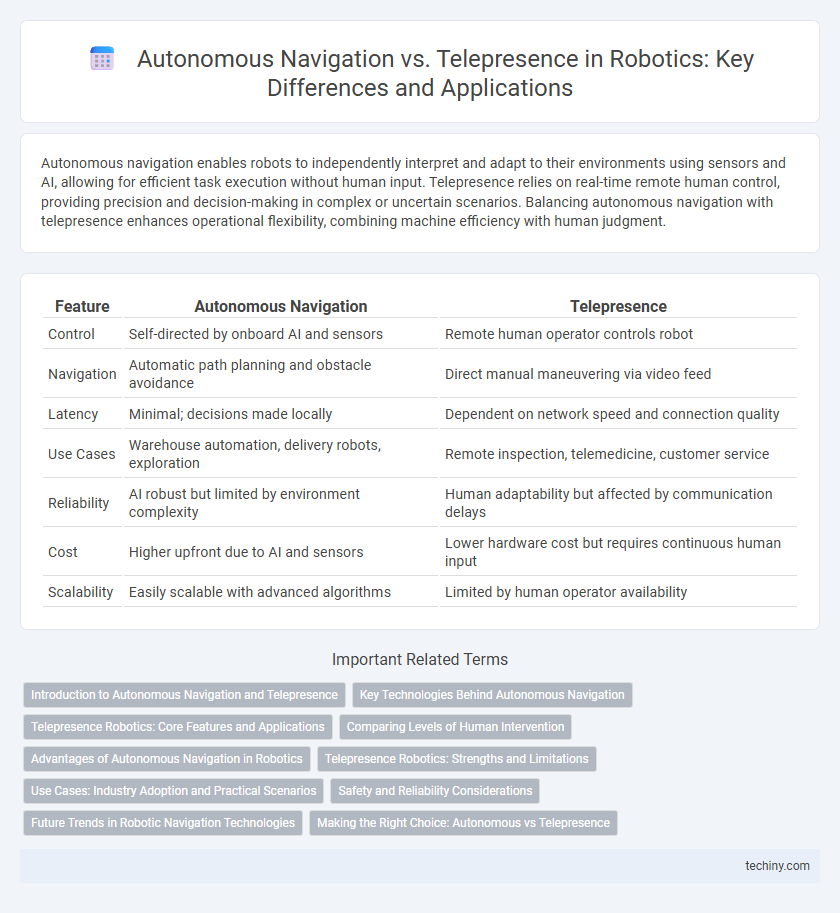Autonomous navigation enables robots to independently interpret and adapt to their environments using sensors and AI, allowing for efficient task execution without human input. Telepresence relies on real-time remote human control, providing precision and decision-making in complex or uncertain scenarios. Balancing autonomous navigation with telepresence enhances operational flexibility, combining machine efficiency with human judgment.
Table of Comparison
| Feature | Autonomous Navigation | Telepresence |
|---|---|---|
| Control | Self-directed by onboard AI and sensors | Remote human operator controls robot |
| Navigation | Automatic path planning and obstacle avoidance | Direct manual maneuvering via video feed |
| Latency | Minimal; decisions made locally | Dependent on network speed and connection quality |
| Use Cases | Warehouse automation, delivery robots, exploration | Remote inspection, telemedicine, customer service |
| Reliability | AI robust but limited by environment complexity | Human adaptability but affected by communication delays |
| Cost | Higher upfront due to AI and sensors | Lower hardware cost but requires continuous human input |
| Scalability | Easily scalable with advanced algorithms | Limited by human operator availability |
Introduction to Autonomous Navigation and Telepresence
Autonomous navigation enables robots to independently perceive, map, and traverse environments using sensors and algorithms such as SLAM (Simultaneous Localization and Mapping). Telepresence relies on remote human operators controlling robots via real-time video and control interfaces, allowing interaction in distant or hazardous locations. The integration of AI advances continuous improvement in autonomous systems, while telepresence emphasizes human judgment and adaptability.
Key Technologies Behind Autonomous Navigation
Autonomous navigation relies on advanced technologies such as LiDAR, computer vision, simultaneous localization and mapping (SLAM), and sensor fusion to enable robots to perceive, interpret, and navigate complex environments without human intervention. In contrast, telepresence systems depend on remote control interfaces and real-time video streaming, limiting their independence and responsiveness. Key innovations in AI-powered path planning and obstacle avoidance algorithms are critical for enhancing the reliability and efficiency of autonomous robotic navigation.
Telepresence Robotics: Core Features and Applications
Telepresence robotics enables remote users to interact with environments through real-time video, audio, and mobility, enhancing communication and presence without physical travel. Core features include high-definition cameras, two-way audio systems, intuitive control interfaces, and autonomous obstacle avoidance for seamless navigation. Applications span healthcare for remote patient monitoring, corporate environments for virtual meetings, and education to facilitate distance learning and remote collaboration.
Comparing Levels of Human Intervention
Autonomous navigation in robotics operates with minimal human intervention, relying on advanced sensors, AI algorithms, and machine learning to make real-time decisions and adapt to dynamic environments. Telepresence robots, however, depend heavily on continuous human control and input to navigate and perform tasks, requiring direct operator engagement. Comparing these levels of human intervention highlights autonomous systems' potential for efficiency and scalability, while telepresence offers precise human judgment in complex or unpredictable scenarios.
Advantages of Autonomous Navigation in Robotics
Autonomous navigation in robotics enables precise, real-time decision-making without human intervention, enhancing operational efficiency and reducing latency in dynamic environments. It leverages advanced sensors and AI algorithms to adapt to unpredictable obstacles, ensuring continuous task execution in complex settings. This autonomy minimizes reliance on external control systems, lowering operational costs and expanding deployment capabilities in remote or hazardous areas.
Telepresence Robotics: Strengths and Limitations
Telepresence robotics enables remote operation, allowing users to interact with environments without physical presence, enhancing accessibility in hazardous or distant locations. Strengths include real-time human decision-making and intuitive control, which improve task flexibility and situational awareness compared to fully autonomous systems. Limitations involve reliance on stable communication networks, latency issues that can impair responsiveness, and limited autonomy that restricts operation in complex or rapidly changing environments.
Use Cases: Industry Adoption and Practical Scenarios
Autonomous navigation is extensively adopted in logistics warehouses for efficient inventory management and automated guided vehicles (AGVs), significantly reducing human intervention and enhancing operational throughput. Telepresence robots find practical applications in healthcare settings, enabling remote consultations and surgery assistance, improving accessibility and patient care. Manufacturing plants utilize a hybrid approach where autonomous robots perform repetitive tasks while telepresence systems allow human experts to remotely troubleshoot and oversee complex operations.
Safety and Reliability Considerations
Autonomous navigation systems leverage advanced sensors and AI algorithms to enhance safety by minimizing human error and enabling real-time obstacle detection, while telepresence relies heavily on operator skills, which can introduce latency and increase the risk of delayed responses. Reliability in autonomous robots is boosted through rigorous testing and redundancy in hardware and software, ensuring consistent performance in dynamic environments. Telepresence systems require stable communication networks to maintain control fidelity, making them vulnerable to connectivity disruptions that can compromise operational safety.
Future Trends in Robotic Navigation Technologies
Future trends in robotic navigation technologies emphasize the integration of autonomous navigation systems enhanced by advanced AI algorithms, enabling robots to independently interpret complex environments with increased precision. Telepresence navigation continues to evolve through high-definition, low-latency communication networks, providing users real-time control and immersive remote experiences. Hybrid models combining autonomous decision-making and telepresence control are emerging, offering flexible, adaptive solutions for diverse industrial and service applications.
Making the Right Choice: Autonomous vs Telepresence
Choosing between autonomous navigation and telepresence depends on the application's complexity and control requirements. Autonomous navigation offers real-time environment mapping and obstacle avoidance using advanced SLAM algorithms, ideal for repetitive or dangerous tasks. Telepresence provides direct human control with immersive feedback, making it suitable for remote inspections or precision tasks where human judgment is critical.
Autonomous navigation vs telepresence Infographic

 techiny.com
techiny.com